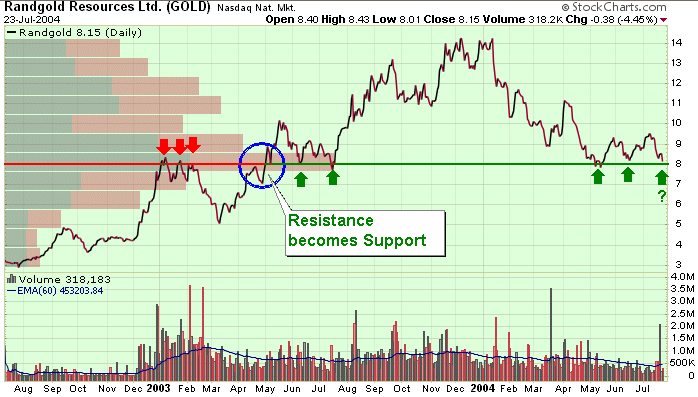I'm always amazed when the "respectable" financial press gets themselves into a lather about the Dow crossing 10,000. From some of the headlines, you'd think that Friday's close at 9962 was completely unexpected and very significant. "Dow tumbles to below 10,000", "Investor angst drops Dow", and "Dow loses fizz to close below 10,000". Of course, then a villain must be found and soon afterwards, one was: "Markets fall on Microsoft, Amazon reports".
Astute ChartWatchers - like you! - should not be surprised at all by this news. Astute ChartWatchers know that the Dow has been in a downtrend for several months now. Downtrends create lower-highs and lower-lows. As soon as the Dow started lower at the end of June - creating its second lower-high and confirming the downtrend - astute ChartWatchers have been expecting a move down to somewhere below 9852, the previous lower-low. Astute ChartWatchers know that Friday's move has very little to do with earnings - it's part of a larger downturn in market sentiment that began back in February.
In a similar vein, all of our commentators are bearish right now. Carl Swenlin's got another article "debunking" some of the standard wisdom being presented as fact by the financial media. Richard Rhodes sees the tech sector heading lower and John Murphy presents a lower long-term target for the S&P. But first, Part 3 of my series on Murphy's Laws...
LAW #3: FIND THE LOW AND THE HIGH OF IT
Murphy's Law #3: Find support and resistance levels. The best place to buy a market is near support levels. That support is usually a previous reaction low. The best place to sell a market is near resistance levels. Resistance is usually a previous peak. After a resistance peak has been broken, it will usually provide support on subsequent pullbacks. In other words, the old "high" becomes the new "low." In the same way, when a support level has been broken, it will usually produce selling on subsequent rallies -- the old "low" can become the new "high." - John Murphy
Support and Resistance are very important technical concepts that are often overlooked, especially when one gets too deep into indicators and oscillators (and all the other "-ators" out there).
Support and resistance seem "magical" to newcomers. "How can some number cause a stock to change direction?" Support and resistance occur because investors have good memories. They know where they bought their current stocks and how much money they've made (or lost) since buying. They also remember how happy (or scared) they were the last time their stock hit a particular level. Put simply, support and resistance are echoes of human nature.
As such, investors should always be aware of important support and resistance levels for the particular stock or market they are following. Many times the standard "Mark 1 Eyeball" is the best tool for finding such levels. Look for points in the "recent" past where a stock reversed direction, then check out the volume around that time. The higher the volume, the more likely it is that the stock will reverse again at that level.
If the "Mark 1 Eyeball" isn't working for you, SharpCharts "Price by Volume" overlay and our "Support/Resistance" annotation tool may do the trick. Here is an example of their use:
Randgold Resources (GOLD) has an affinity for 8.0. Notice how the horizontal Price-by-Volume bar for the 7.5 to 8.5 range sticks out much farther than the other bars? That means that whenever GOLD has been near 8.0, volume has increased. 8.0 is a level that makes large numbers of shareholders want to buy or sell their shares.
By adding a Support/Resistance line at 8.0 with our ChartNotes annotation tool, we can clearly see where 8.0 was initially a resistance level (3 red arrows) and then, in May 2003, then stock punched up through 8.0 which then became a support level (2 green arrows). That is a perfect example of the phenomenon that John was referring to in Law #3. Those green arrows were great buying opportunities as the stock soon shot up over 70% in the following months.
Recently, 8.0 has been providing more support for GOLD, but without the strong volume spikes that often accompany these tests. The "Resistance becomes Support" phenomenon may be about to work in reverse soon (green question mark). I suspect that GOLD shareholders will be nervously watching the stock next week.


